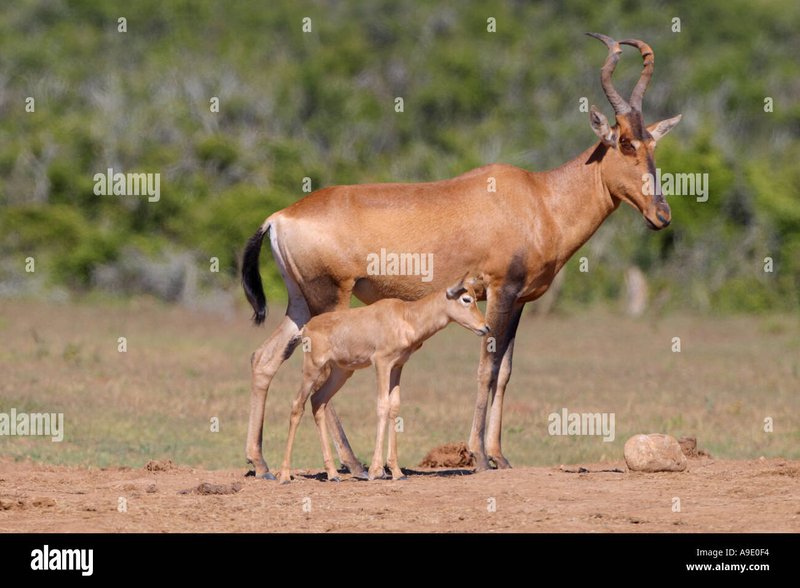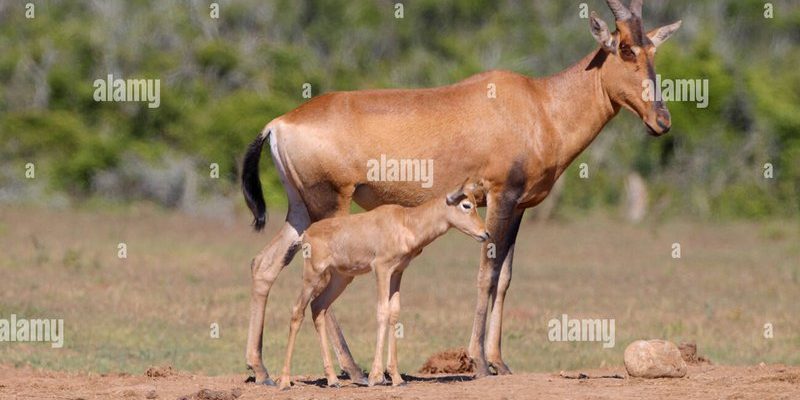
As you sip your coffee, picture a young hartebeest calf wobbly on its legs, trying to keep up with its protective mother. The process of raising a calf in the wild isn’t as simple as it sounds. Mother hartebeests face multiple challenges, from predators lurking nearby to the need for constant nourishment. In this article, we’ll explore the various ways hartebeests nurture and protect their young, highlighting their survival instincts and the dynamics of their social structure.
The Birth of a Calf
Hartebeests typically give birth after a gestation period of around 7-8 months. It’s an exciting time for a mother hartebeest, but it’s also fraught with danger. When the time comes, the mother seeks a secluded spot to deliver her calf, trying to avoid the watchful eyes of predators. This location choice is crucial—mothers want to ensure their newborn is as safe as possible during those first vulnerable moments.
Once the calf is born, it’s often up and standing within a short time—usually within an hour. This quick mobility is vital for survival in the wild, especially when predators like lions or hyenas roam nearby. The mother’s instinct kicks in; she stays close, offering warmth and safety while encouraging her calf to start walking and feeding. It’s a bit like watching a toddler take their first steps—wobbly but determined.
Protective Parenting
Here’s the thing: hartebeest mothers aren’t just protective; they’re also very strategic. They often form small groups, also known as crèches, with other mothers and their young. This collective approach allows for vigilant monitoring of the surroundings. Imagine it like a neighborhood watch for calves! While one mother keeps an eye on her little one, others can be on lookout for any signs of danger.
Additionally, if a predator approaches, these mothers will go to great lengths to defend their young. They might even pretend to be injured to distract a predator, giving their calf a chance to escape. This kind of self-sacrifice showcases the deep bond between mothers and their young and emphasizes the importance of protecting the next generation.
Feeding and Nutrition
For young hartebeests, nourishment is key. At first, calves rely entirely on their mother’s milk, which is packed with the nutrients they need to grow. Within a few weeks, they start munching on grass, mimicking their mothers. The transition to solid food is gradual, helping to build their digestive systems.
Hartebeests are often found grazing on open grasslands, where they can access a rich food source. You might be wondering how a calf learns what to eat. Well, mothers are great teachers! They guide their calves, showing them what to munch on and what to avoid. Just like humans guiding children through new experiences, these mothers ensure their young develop a healthy diet.
Learning Survival Skills
As calves grow, their mothers teach them essential survival skills. Young hartebeests are naturally curious and eager to explore their surroundings. Mothers encourage this curiosity while keeping a watchful eye. They teach their calves how to recognize threats and react appropriately.
For instance, if there’s a warning call from a herd member, the mother will signal to her calf to stay close and low, blending into the grass. This instinct to hide is crucial; it’s about survival. These lessons are simple yet profound—small actions that can make a world of difference in the life of a calf.
Social Structure and Learning from Others
Hartebeests are social creatures, and this social structure plays a significant role in raising young. Not only do mothers look out for their own calves, but other members of the herd also pitch in. It’s not uncommon for a calf to have multiple “aunties” watching over it. This broader care system helps create a sense of community, which is vital for survival.
As calves interact with others, they learn social skills and establish their place within the herd. They play with each other, practice running, and even simulate challenges they might face as adults. These interactions are crucial for developing confidence and building bonds, essential traits for their future life as an adult hartebeest.
Challenges in the Wild
Raising young in the wild isn’t without its challenges. Hartebeests face threats from predators, environmental changes, and competition for resources. Mothers must constantly be vigilant, ensuring their calves stay safe. Unfortunately, not all calves make it to adulthood, which is a tough reality in the wild.
Weather can also impact the availability of food and water, making it harder for mothers to provide. In times of drought, for example, hartebeests may have to travel great distances to find grazing grounds. This journey adds stress and risk to the already challenging task of raising young.
In the wild, hartebeests exemplify the dedication and resilience required to raise their young. Every step, from birth to learning survival skills, highlights their strong maternal instincts and the tight-knit community that supports them. Watching a mother hartebeest nurture her calf is a heartwarming reminder of the bonds that exist in nature, where each life is a thread in the larger tapestry of the ecosystem.
As we reflect on these incredible animals, it’s clear how complex and beautiful their world is. Their strategies and structures give us a glimpse into the wonders of wildlife parenting. Whether through cooperation in the herd or fierce protection from predators, hartebeests remind us that raising young—whether in the wild or in a human context—requires love, patience, and a bit of teamwork.

